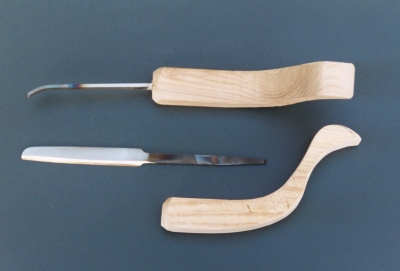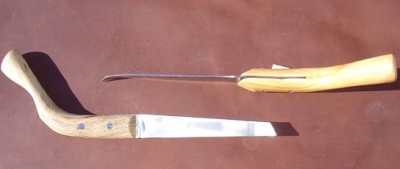Crooked Knives
-
Pole and Paddle Crooked Knives
$60.00

Price may be higher, depending on customer specifications
-
Manufactured Crooked Knives
$50.00

The crooked knife you purchase is a truly historic woodworking tool, reproduced in fine Sheffield steel and bearing authorized, historic trademarks. The crooked knife is essentially a one handed draw knife. The curvature of the blade, especially at the tip, facilitates carving concave surfaces. Nevertheless, the chief purpose of the gentle curvature is to allow smooth, easy separation of the chip from the workpiece. The slight curvature also permits the blade to remain slightly above the working surface, giving very precise control with changes in engagement angle. Careful practice with a properly sharpened blade will reveal the potential of the crooked knife. Keep in mind that you will most often be using your crooked knife with your palm turned upwards, thumb resting in the recessed upper portion of the curved handle, blade pulled towards you. The flat of the blade is oriented down on the work piece.
While your knife can be used directly as you purchased it, finish sharpening and honing will yield the best results. Further, the angle of sharpening at the edge of the blade has been formed at the factory for "general purpose" use. You may elect to decrease this angle if you intend to use your crooked knife for wasting large amounts of wood in a short time. It is recommended that you first give a final honing or polish to the factory edge first and try it out before altering the edge angle. Those skilled in the sharpening of professional woodworking tools may also elect to use a burnisher to slightly "turn down" or roll the edge down from the top surface. Some users, including Native Americans, find that this burnishing helps give a better "bite". Sharpening is very critical to get the truly excellent results this blade can deliver. Take the time to do it right, and do not worry about marks or scratches on the blade. These can always be polished out or left alone. This is a tool to use. Use of power equipment, unless carefully done with water lubrication, is not advised. It is too easy to ruin the temper of this thin blade by overheating. Keep in mind that the bottom of the blade should always be sharpened to remain dead flat, like a chisel. A small, curved slipstone will facilitate honing of the upper curved portion of the blade. If you desire to decrease the blade edge angle, only alter the angle of the upper surface; leave the bottom dead flat.
Warning: If you are unfamiliar with how to use cutting tools that are drawn towards the body get competent instruction before use. It is possible to cut yourself, especially on the opposite arm holding the work piece, if you are not holding the tool or work properly and are not familiar with using opposing muscles to brake the tool and prevent cuts going out of control. Safe use is your responsibility and cannot be taught from instructional manuals alone. Competent instruction is essential in the use of any edged wood working tools. A good book for reference, in addition to competent personal instruction, which discusses a wide variety of similar carving methods is "Swedish Carving Techniques" by Wille Sundquist. ISBN 0-942391-45-4.

